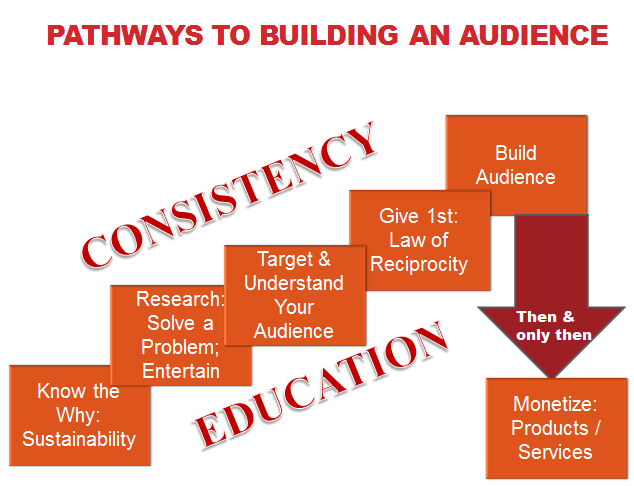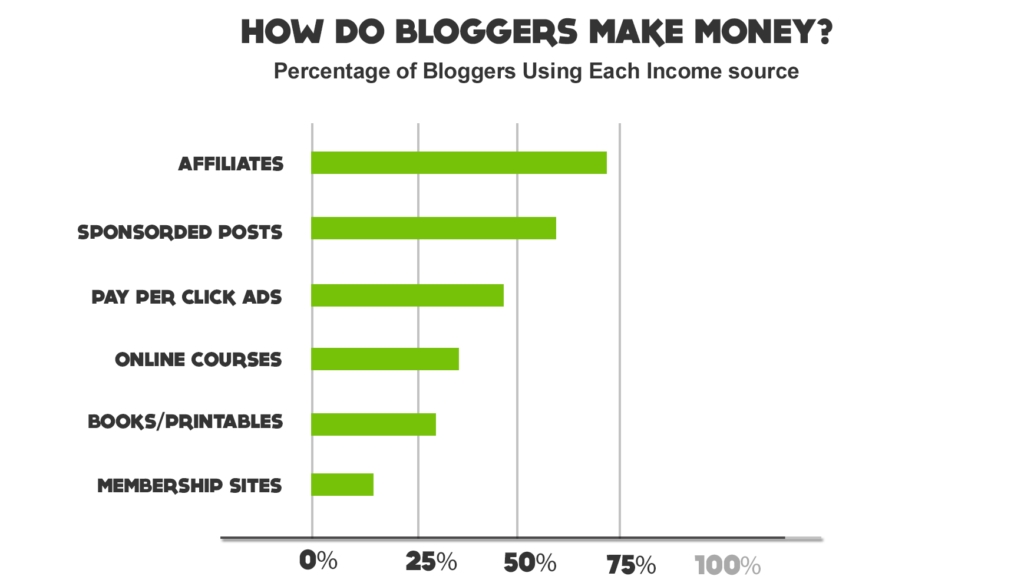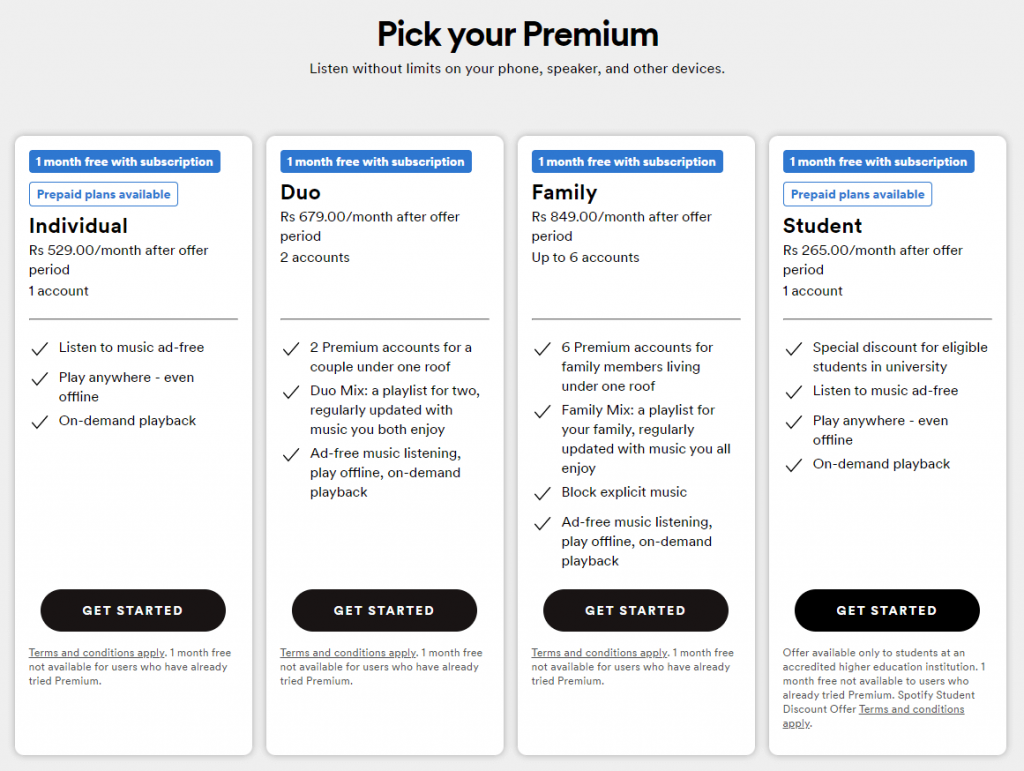How to Make Money with a Blog (Complete Guide)
it is possible for beginners to make money with a blog. While it requires time, effort, and dedication, blogging can be a legitimate way to generate income and make a living. The low barrier to entry, combined with basic knowledge of blogging, SEO, and understanding of the Internet, allows beginners to start a blogging business and earn money. However, it’s important to note that success in blogging requires consistent effort, valuable content, building an audience, and implementing effective monetization strategies.
In this article, we will explore how to make money with a blog, step by step, so you can turn your passion for writing into a profitable online business.
Setting up the Blog Step by Step Guide
Choose a Profitable Niche:
In the vast world of business opportunities, choosing a profitable niche is a critical step towards achieving success. Here are essential factors to consider when selecting a niche that can propel your business to new heights:
Research and Analysis: Conduct thorough research to identify market trends, customer demands, and areas of growth potential. Analyze the competition and identify gaps where your unique offerings can shine.
Passion and Expertise: Pursue a niche that aligns with your passions and expertise. Your genuine interest and knowledge in the niche will fuel your motivation and commitment to excel.
Target Audience: Define your target audience and understand their needs, preferences, and pain points. Tailor your products or services to cater to their specific requirements.
Profit Potential: Assess the profit potential of the niche. Consider the pricing dynamics, profit margins, and scalability of the business model.
Long-Term Viability: Aim for a niche with long-term viability and sustainability. Avoid trends that may fade quickly, and instead focus on evergreen markets.
Low Competition and High Demand: Strive to enter a niche with relatively low competition and high demand. This allows you to establish a strong foothold and attract a loyal customer base.
Differentiation: Identify ways to stand out from the competition. Offer unique value propositions and exceptional customer experiences to set your business apart.
Profitability Analysis: Conduct a thorough profitability analysis, considering costs, marketing expenses, and potential revenue streams. Ensure that your chosen niche offers a viable path to profitability.
Market Size: Consider the market size of your chosen niche. A niche with a substantial customer base provides more opportunities for growth.
Trends and Forecasts: Study industry trends and forecasts to anticipate future demands and challenges. Position yourself to adapt and thrive as the market evolves.
Choosing a profitable niche requires thoughtful consideration and analysis. Look for a niche that aligns with your passion and expertise, offers a sizable customer base, and has potential for long-term growth. Conduct in-depth research, evaluate competition and demand, and ensure that your niche aligns with your business goals. By making an informed decision, you set the stage for a successful and fulfilling entrepreneurial journey.
Set Up Your Blog:

Choose a Blogging Platform: Select a reliable and user-friendly blogging platform. Popular options include WordPress, Blogger, and Wix. Consider your technical proficiency and the features you need before making your decision.
Pick a Domain Name: Choose a unique and memorable domain name that represents your blog’s identity. Aim for a name that is easy to spell, reflects your niche, and resonates with your audience.
Register Your Domain: Once you’ve decided on a domain name, register it with a domain registrar. Many platforms offer domain registration services, or you can use a separate domain registrar like GoDaddy or Namecheap.
Select Hosting Provider: Choose a hosting provider that suits your needs and budget. Hosting is essential for making your blog accessible on the internet. Look for reliable uptime, fast loading times, and excellent customer support.
Install Blogging Platform: Install your chosen blogging platform on your hosting account. Most hosting providers offer one-click installations for popular platforms like WordPress.
Customize Your Blog’s Design: Personalize the design of your blog to match your brand and style. Choose a theme or template that complements your content and is visually appealing to your audience.
Create Essential Pages: Set up essential pages for your blog, such as About, Contact, and Privacy Policy. These pages provide important information about you, your blog, and how visitors can get in touch.
Plan Content Strategy: Develop a content strategy outlining the topics you’ll cover, posting frequency, and target audience. Consistency and relevance are key to building a loyal readership.
Write Compelling Content: Start creating and publishing content that resonates with your audience. Craft engaging and informative posts that showcase your expertise and passion.
Optimize for SEO: Implement search engine optimization (SEO) techniques to improve your blog’s visibility on search engines. Use relevant keywords, meta tags, and high-quality content to attract organic traffic.
Promote Your Blog: Share your blog posts on social media platforms to reach a wider audience. Engage with your readers, respond to comments, and network with other bloggers in your niche.
Monitor Analytics: Track your blog’s performance using analytics tools. Analyze traffic, audience demographics, and popular content to refine your strategy and grow your blog effectively.
Stay Consistent: Consistency is key to building a successful blog. Stick to your content schedule, engage with your readers, and continuously improve your blog to provide value to your audience.
Setting up your blog is a rewarding experience that allows you to share your passion with the world. Follow these steps to create a well-designed, engaging, and SEO-optimized blog. Be consistent in creating compelling content and promoting your blog to attract a loyal readership. Embrace your creativity, stay true to your voice, and enjoy the journey of blogging success!
Create High-Quality Content:

Diverse Content Types: Offer a diverse range of content types to cater to different preferences. Write well-researched articles, step-by-step tutorials, comprehensive guides, and honest product reviews. Additionally, sharing your personal experiences and expertise adds authenticity and relatability to your content.
Research and Credibility: Prioritize thorough research to back your claims and provide accurate information. Credibility is crucial to gaining the trust of your audience and positioning yourself as an authoritative voice in your niche.
Consistent Schedule: Develop a consistent content schedule that keeps your readers engaged and eagerly anticipating your next piece. Consistency fosters reliability, and regular updates demonstrate your commitment to providing valuable content.
Engaging Language: Craft your content with a conversational and engaging tone. Avoid jargon and use language that connects with your audience on a personal level. Encourage interactions by asking questions and inviting comments.
Visual Appeal: Enhance your content with eye-catching images, infographics, and multimedia elements. Visuals not only break up the text but also add depth and appeal to your message.
Search Engine Optimization (SEO): Optimize your content for search engines to improve its discoverability. Include relevant keywords naturally throughout your articles, and create attention-grabbing meta tags to entice readers to click through to your content.
Structured Format: Organize your content with clear headings, subheadings, and bullet points. A well-structured format makes it easy for readers to scan your content and find the information they seek.
Problem Solving: Identify common problems or questions within your niche, and aim to provide valuable solutions and answers. Addressing your audience’s pain points positions you as a problem solver and a reliable resource.
Value-Oriented: Always prioritize providing value to your readers. Whether it’s offering practical tips, actionable advice, or insightful knowledge, content that enriches your audience’s lives will be appreciated and shared.
Call-to-Action (CTA): Include a clear and compelling call-to-action at the end of your content. Encourage readers to take the next step, such as subscribing to your newsletter, exploring related articles, or engaging with your brand on social media.
Build an Audience:

Promoting your blog is a crucial step to expand your audience and establish your online presence. Embrace these strategies to effectively promote your blog and foster a strong connection with your readers:
Social Media Engagement: Create dedicated social media profiles for your blog on platforms like Facebook, Twitter, Instagram, and LinkedIn. Regularly share your content, engage with your followers, and respond to comments and messages promptly. Leverage social media to spark discussions and build a loyal community around your blog.
Online Communities and Forums: Identify relevant online communities and forums in your niche. Participate in discussions, offer valuable insights, and share your blog posts when appropriate. Respect the community guidelines and contribute genuinely to become a respected member within those communities.
Guest Posting on Popular Blogs: Guest post on other popular blogs within your niche to reach a wider audience. Offer unique and informative content that showcases your expertise. This exposure will drive traffic back to your blog and establish you as a reputable authority in your field.
Networking and Collaboration: Network with fellow bloggers and industry influencers to expand your reach. Collaborate on content, cross-promote each other’s work, or host joint webinars or events. Building mutually beneficial relationships opens doors to new opportunities and a larger audience.
Email List Incentives: Entice readers to subscribe to your email list by offering exclusive content, valuable resources, discounts, or freebies. A strong email list allows you to engage with your audience directly and keep them updated on your latest content and offerings.
Active Audience Engagement: Engage actively with your audience by responding to comments on your blog and social media platforms. Foster a sense of community and trust by being approachable and attentive to your readers’ feedback.
Repurposing Content: Repurpose your blog content into different formats, such as infographics, videos, or podcasts. This allows you to reach audiences on various platforms and caters to different preferences.
Cross-Promotion with Influencers: Collaborate with influencers in your niche to promote your blog. Offer them valuable content or products to review, and they can share their experiences with their followers, leading to increased visibility for your blog.
SEO Optimization: Optimize your blog posts for search engines by using relevant keywords, meta tags, and descriptive headings. This will improve your blog’s ranking on search engine result pages and attract organic traffic.
By actively promoting your blog through various channels, engaging with your audience, and collaborating with fellow bloggers and influencers, you can maximize your blog’s reach and impact. Embrace social media, guest posting, email incentives, and networking opportunities to create a thriving community around your blog. Consistency and genuine interactions will solidify your blog’s reputation and build lasting relationships with your readers.
Monetization Strategies for Your Blog

Monetize Your Blog:
Display Advertising: Sign up for ad networks like Google AdSense, Media.net, or Ezoic, and place ads on your blog. Optimize ad placement and experiment with different ad formats to maximize earnings.
Affiliate Marketing: Join affiliate programs related to your niche, such as Amazon Associates, ShareASale, or CJ Affiliate, and promote products or services using unique affiliate links. Earn a commission for each sale or referral made through your affiliate links.
Sponsored Posts: Collaborate with brands or companies that align with your blog’s niche and values. Write sponsored content promoting their products or services in exchange for compensation.
Digital ProductsServices: Offer services: Create and sell your own digital products, such as e-books, online courses, templates, or stock photos. Package your expertise into valuable resources that your audience is willing to pay for.
related to your niche, such as consulting, coaching, web design, or freelance writing. Leverage your expertise to provide personalized solutions to your audience.
Optimize for Revenue:
Continually track and analyze your blog’s performance using tools like Google Analytics. Monitor your traffic, engagement metrics, and revenue to identify areas for improvement.
Test different ad placements, sizes, and networks to find the best combination for maximizing ad revenue without compromising the user experience.
Explore different affiliate programs and products to find those that resonate well with your audience and offer higher commissions.
Consider creating landing pages or dedicated sales funnels to promote your digital products or services effectively.
Experiment with pricing strategies, discounts, or limited-time offers to encourage conversions.
Build Relationships:

Network with other bloggers, industry influencers, and potential advertisers in your niche.
Attend conferences, workshops, or online events to connect with like-minded individuals and stay updated on industry trends.
Collaborate on guest posts, podcasts, interviews, or joint ventures to expand your reach and tap into new audiences.
Engage with your fellow bloggers by commenting on their posts, sharing their content, or featuring them in your own articles. Building genuine relationships can lead to mutually beneficial opportunities.
Stay Consistent and Evolve:
Consistently publish high-quality content to maintain and grow your audience. Regularly update your blog with fresh and relevant information to keep readers coming back.
Adapt to industry trends and changes in user behavior. Stay updated on new tools, technologies, and strategies that can enhance your blog’s performance and revenue potential.
Continuously learn and improve your blogging skills by investing time in educational resources, attending webinars or workshops, reading books, or joining online courses.
Stay persistent and patient, as building a profitable blog takes time and effort. Don’t be discouraged by initial slow progress and keep focusing on providing value to your audience.
Remember, building a successful and profitable blog requires dedication, consistency, and a deep understanding of your target audience. With the right strategies, monetization methods, and continuous improvement, you can turn your blog into a lucrative source of income.
Implement Email Marketing

Building an email list and leveraging it to nurture relationships with your audience is a crucial aspect of digital marketing and business growth. An email list consists of a group of individuals who have voluntarily provided their email addresses to receive updates, promotions, and exclusive content from you. Here’s a step-by-step explanation of the process and its benefits:
Collect Email Subscribers: Start by collecting email subscribers through various channels. This can be done by offering signup forms on your website, landing pages, blog posts, social media platforms, or even through in-person events. To encourage signups, provide incentives like free e-books, guides, webinars, or discount codes that align with the interests of your target audience.
Segmentation: As your email list grows, consider segmenting it based on various criteria such as demographics, interests, purchase history, or engagement level. Segmentation allows you to send targeted and personalized content to different groups, increasing the relevance and effectiveness of your emails.
Engaging Content: Regularly provide valuable and engaging content to your subscribers. This can include informative blog posts, educational videos, industry insights, case studies, and more. Offer content that addresses the pain points and interests of your audience, demonstrating your expertise and building trust.
Exclusive Content and Promotions: To incentivize subscribers to stay engaged, offer exclusive content or promotions that are not available to the general public. This could be early access to new products or services, limited-time discounts, or access to members-only webinars or events. Exclusive content and promotions make subscribers feel valued and appreciated, fostering stronger relationships.
Automated Email Campaigns: Implement automated email campaigns using email marketing tools. For example, you can set up a welcome series for new subscribers, a drip campaign to nurture leads, or a re-engagement campaign for inactive subscribers. Automation saves time and ensures timely and relevant communication with your audience.
Two-Way Communication: Encourage two-way communication by inviting subscribers to reply to your emails, ask questions, or provide feedback. Engage with those who respond, as it creates a sense of personal connection and shows that you genuinely care about their opinions.
Promote Products and Services: While nurturing relationships, strategically promote your products or services when relevant. Avoid being overly salesy and focus on providing value. When subscribers trust you and find your content helpful, they are more likely to consider your offerings.
Affiliate Sales: If you have affiliate partnerships, you can occasionally include affiliate promotions in your emails. Ensure that the products or services you promote align with your audience’s interests and needs. Transparency is essential; clearly disclose any affiliate relationships.
Benefits of Building an Engaged Email List:
a. Targeted Reach: With a segmented email list, you can send targeted messages to specific groups, increasing the likelihood of resonating with your audience.
b. Higher Conversion Rates: Engaged subscribers are more likely to convert into customers. They have already shown interest in your content and offerings.
c. Brand Loyalty: Nurturing relationships through email helps build brand loyalty and trust, leading to long-term customer relationships.
d. Cost-Effective Marketing: Email marketing is cost-effective compared to traditional advertising methods, providing an excellent return on investment.
e. Control and Ownership: Unlike social media platforms, you have full control and ownership of your email list, reducing dependency on external platforms.
f. Repeat Business and Referrals: Satisfied customers from your email list are more likely to make repeat purchases and refer your products or services to others.
Building and nurturing an engaged email list requires consistent effort, valuable content, and understanding your audience’s needs. Over time, a well-crafted email list can become a powerful asset for promoting your products, services, and affiliate offerings while fostering strong connections with your audience.
Diversify Income Streams

Relying solely on one income stream can indeed pose financial risks, especially in uncertain economic conditions or changing market dynamics. Diversifying your revenue sources is a smart strategy that can provide stability and security for your business. Here’s how combining multiple strategies like affiliate marketing, advertising, and digital products can be beneficial:
Affiliate Marketing: Affiliate marketing involves promoting products or services of other companies and earning a commission for each sale or lead generated through your referral. By participating in affiliate programs, you can leverage your website, blog, or social media presence to earn passive income. If one affiliate partner’s performance fluctuates, you can still rely on other partnerships to maintain revenue.
Advertising: Monetizing your online platform through advertising can be a reliable source of income. You can display ads on your website, YouTube channel, or social media platforms and earn revenue based on impressions or clicks. Having a diverse set of advertisers ensures that revenue remains steady, even if the performance of one advertiser declines.
Digital Products: Creating and selling digital products, such as e-books, online courses, software, or templates, can be a lucrative income stream. Once developed, digital products can be sold repeatedly without incurring additional manufacturing or distribution costs. Diversifying your range of digital products can attract different customer segments and broaden your income sources.
Benefits of Diversifying Revenue Sources:
a. Stability: Different income streams can balance out fluctuations in individual sources, providing a more stable overall income.
b. Reduced Dependency: Relying on a single income source means your financial well-being is entirely dependent on its success. Diversification reduces this dependency.
c. Adaptability: If market conditions change or consumer preferences shift, having diverse revenue sources allows you to adapt and cater to different demands.
d. Scalability: Different strategies can have varying growth potentials, allowing you to scale and expand your business in different directions.
e. Risk Mitigation: A downturn in one sector or industry won’t impact your entire income if you have multiple revenue streams.
f. Leveraging Strengths: Each income source can leverage your unique strengths and expertise, enhancing overall profitability.
Remember that diversification should be done strategically. Avoid spreading yourself too thin, as managing multiple revenue streams can be time-consuming. Instead, focus on areas that complement your core business and align with your target audience.
Regularly assess the performance of each revenue stream and adapt your strategies accordingly. Invest time in optimizing and improving your most successful streams to maximize their potential.
Diversifying your income sources not only enhances financial security but also allows you to explore new opportunities and stay ahead in an ever-changing business landscape. By combining affiliate marketing, advertising, and digital products, you can create a well-rounded income strategy that provides stability and growth for your business.
Engage with Your Audience

Interacting with your readers is a crucial aspect of building a loyal and engaged community around your content or business. By actively engaging with your audience through comments, social media, and emails, you can foster stronger connections and gain valuable insights into their preferences and needs. Here’s why and how to interact with your readers effectively:
Responding to Queries: When readers leave comments or send emails with questions, take the time to respond promptly and helpfully. Addressing their queries shows that you value their engagement and are willing to provide assistance.
Listening to Feedback: Pay close attention to the feedback you receive, whether positive or constructive. Feedback helps you understand what resonates with your audience and allows you to improve your content or offerings based on their preferences.
Understanding Needs: Engaging with your readers enables you to gain insights into their needs, pain points, and interests. By understanding their preferences, you can tailor your content or products to better serve them.
Social Media Engagement: Be active on social media platforms where your audience is present. Respond to comments, direct messages, and mentions. Engage in conversations, share valuable content, and participate in discussions relevant to your niche.
Email Communication: Leverage email marketing to nurture relationships with your readers. Send personalized emails, exclusive content, promotions, and updates to keep them informed and engaged. Use automation to deliver targeted messages based on their behavior and preferences.
Encourage User-Generated Content: Encourage your audience to create and share content related to your brand or products. User-generated content not only fosters a sense of community but also acts as a powerful word-of-mouth marketing tool.
Be Authentic and Transparent: Show authenticity and transparency in your interactions. People appreciate genuine connections and are more likely to support brands or individuals they trust.
Create Polls and Surveys: Use polls and surveys to gather direct feedback from your audience. Ask them about their preferences, interests, and pain points. This data can help you make informed decisions and tailor your content or products accordingly.
Benefits of Interacting with Readers:
a. Builds Trust and Loyalty: Engaging with your audience shows that you care about their opinions and value their input, leading to increased trust and loyalty.
b. Boosts Engagement: Active interactions lead to higher engagement levels on your website, social media, and emails.
c. Enhances Customer Satisfaction: Responding to queries and feedback promptly ensures that your readers feel heard and appreciated, leading to higher customer satisfaction.
d. Valuable Insights: Engaging with your audience provides valuable insights into their preferences and needs, guiding your content creation and marketing strategies.
e. Word-of-Mouth Marketing: A loyal community is more likely to share your content, products, or services with others, leading to organic word-of-mouth marketing.
f. Iterative Improvement: Feedback and interactions help you continuously improve and refine your offerings to better meet your audience’s expectations.
Remember that building a loyal community takes time and consistent effort. Be patient and committed to nurturing your relationships with readers. By actively engaging with your audience through various channels, you can create a thriving community that supports your brand and advocates for your content, products, or services.
Optimize for Search Engines

SEO (Search Engine Optimization) is indeed a critical factor in driving organic traffic to your blog or website. By optimizing your content and website elements, you can improve your search engine rankings and attract more visitors. Here are some essential SEO practices to implement:
Keyword Research: Conduct thorough keyword research to identify relevant and high-traffic keywords related to your blog’s niche. Use keyword research tools to find popular search terms that align with your content.
Optimize Content: Incorporate your target keywords strategically into your blog posts. However, prioritize providing valuable and informative content for your readers rather than keyword stuffing. Aim to create comprehensive, well-structured, and engaging articles that address the needs of your audience.
Meta Tags Optimization: Optimize your meta tags, including the meta title and meta description, for each blog post. The meta title should contain your primary keyword and be descriptive yet concise. The meta description should provide a compelling summary of the content, encouraging users to click through to your blog.
URL Optimization: Create SEO-friendly URLs that include relevant keywords and accurately represent the content of your blog post. Avoid using lengthy or irrelevant strings of characters in your URLs.
Internal Linking: Incorporate internal links within your blog posts to connect related content on your website. Internal linking enhances user navigation, improves the website’s structure, and helps search engines understand the relationships between different pages on your site.
Mobile-Friendly Design: Ensure your blog is optimized for mobile devices, as a significant portion of internet users access content on their smartphones and tablets. Google prioritizes mobile-friendly websites in its search results.
Site Speed Optimization: Improve your website’s loading speed to provide a better user experience. Page speed is a ranking factor, and a fast-loading website enhances user satisfaction and reduces bounce rates.
Featured Snippets: Aim for featured snippets by providing concise and direct answers to commonly asked questions related to your niche. Featured snippets appear at the top of search results, increasing your visibility and credibility.
Quality Backlinks: Earn high-quality backlinks from reputable websites within your industry. Backlinks from authoritative sources signal to search engines that your content is valuable and relevant.
Regular Updates: Publish fresh and relevant content regularly. Search engines favor websites that consistently produce valuable and up-to-date information.
Social Media Promotion: Share your blog posts on social media platforms to increase visibility and attract more traffic. Social media engagement can also indirectly impact your SEO efforts.
SEO is an ongoing process, and it’s essential to monitor your website’s performance and make adjustments based on analytics and search trends. By implementing these SEO best practices, you can enhance your blog’s visibility, attract organic traffic, and build a loyal readership.

Social media platforms play a crucial role in expanding the reach of your blog and attracting more visitors. By creating shareable content and actively engaging with your audience on platforms like Facebook, Twitter, Instagram, and Pinterest, you can build a strong social media presence that drives traffic to your blog and opens up revenue opportunities. Here’s how to leverage social media effectively for your blog:
Create Shareable Content: Craft engaging and valuable content that resonates with your target audience. Shareable content includes informative blog posts, eye-catching images, infographics, videos, and other formats that encourage users to like, comment, and share with their followers.
Choose Relevant Platforms: Identify the social media platforms where your target audience is most active. Different platforms attract diverse audiences, so tailor your content and approach based on each platform’s characteristics.
Consistency is Key: Maintain a consistent posting schedule on social media. Regularly share new blog posts, updates, and valuable content to keep your audience engaged and interested.
Use Visuals: Visual content tends to perform better on social media. Incorporate high-quality images, graphics, and videos to make your posts more appealing and shareable.
Engage with Your Audience: Actively interact with your followers by responding to comments, messages, and mentions. Engaging with your audience fosters a sense of community and encourages more people to participate in conversations related to your blog.
Hashtags and Keywords: Use relevant hashtags and keywords in your social media posts to increase discoverability. Hashtags help users find content on specific topics, and keywords make your posts more SEO-friendly within social media platforms’ search functions.
Promote Blog Posts: Share your blog posts on social media platforms, providing a brief summary and a compelling call-to-action to encourage readers to click through to your blog.
Encourage Sharing: Include social media sharing buttons on your blog posts, making it easy for readers to share your content on their own social media profiles.
Cross-Promote: Collaborate with other bloggers or influencers in your niche to cross-promote each other’s content. This mutual support can introduce your blog to a wider audience.
Track Performance: Monitor the performance of your social media efforts using analytics tools. Analyze engagement metrics, click-through rates, and other data to understand which posts resonate best with your audience.
Benefits of Leveraging Social Media for Your Blog:
a. Expanded Reach: Social media platforms enable your blog to reach a broader audience beyond your website’s regular visitors.
b. Increased Blog Traffic: Engaging and shareable content can drive more traffic to your blog as followers share your posts with their networks.
c. Enhanced Brand Awareness: Consistent social media presence helps build brand recognition and awareness.
d. Opportunity for Networking: Social media allows you to connect with other bloggers, influencers, and industry professionals, expanding your network.
e. Revenue Opportunities: A larger audience and increased blog traffic create potential revenue opportunities through advertising, sponsored content, or affiliate marketing.
Remember that building a strong social media presence takes time and effort. Focus on providing value to your audience, fostering engagement, and cultivating a positive community around your blog. Over time, social media can become a powerful tool to amplify your blog’s reach and grow your online presence.
Collaborate with Other Bloggers

Collaborating with other bloggers or influencers in your niche is an effective strategy to expand the reach of your blog and attract new readers. By engaging in activities like guest posting and co-creating content, you can expose your blog to a broader audience and establish yourself as an authority within your community. Here’s how to leverage collaborations to benefit your blog:
Identify Relevant Partners: Look for bloggers or influencers in your niche whose audience aligns with your target readers. Choose partners who share similar interests, expertise, or complementary content.
Guest Posting: Reach out to other bloggers and offer to write guest posts for their websites. Guest posting allows you to showcase your expertise to a new audience and include a link back to your blog, driving traffic and potential new readers.
Co-Creating Content: Collaborate with other bloggers or influencers to create valuable content together. This could be in the form of co-authored blog posts, joint webinars, podcasts, or video collaborations. By combining your expertise, you offer unique insights and attract a wider audience.
Host Interviews or Features: Invite influencers or experts in your niche to participate in interviews or contribute to your blog. Their involvement can attract their followers to your content, increasing exposure and credibility.
Share and Promote Collaborative Content: Once you’ve created content together, both parties should actively share and promote it on their respective platforms. This cross-promotion maximizes the visibility of the collaborative content.
Build Relationships: Approach collaborations as an opportunity to build meaningful relationships within your niche. Nurture these connections over time, as they can lead to further collaboration opportunities and mutual support.
Participate in Blog Hops or Roundups: Engage in blog hops, where multiple bloggers publish related posts on a specific topic, or participate in roundup posts where a group of bloggers contributes their insights on a particular subject. These activities expose your blog to a wider audience and strengthen your authority.
Benefits of Collaborating with Bloggers and Influencers:
Wider Exposure: Collaborations introduce your blog to a broader audience, increasing its visibility and attracting new readers.
Enhanced Credibility: Being associated with respected bloggers or influencers boosts your credibility and authority within the niche.
Quality Backlinks: Guest posting and co-creating content often result in quality backlinks to your blog, which positively impact your search engine rankings.
Knowledge Sharing: Collaborating with others allows you to share knowledge and insights, providing value to both your audience and theirs.
Networking Opportunities: Collaborations provide networking opportunities, leading to potential partnerships, joint projects, or professional growth.
Remember that successful collaborations require mutual respect, clear communication, and a focus on creating value for both parties’ audiences. Approach collaborations with a genuine desire to share knowledge and provide valuable content. By fostering relationships and partnering with others in your niche, you can amplify the impact of your blog and continue to grow your readership.
Track and Analyze Performance

Regularly monitoring your blog’s performance using analytics tools is essential for understanding how well your blog is performing and identifying areas for improvement. By analyzing traffic, engagement, and conversion data, you can gain valuable insights that can help you adjust your strategies and maximize your blog’s earning potential. Here’s how to use analytics effectively to optimize your blog:
Choose the Right Analytics Tools: Select the appropriate analytics tools for your blog. Popular options include Google Analytics, which provides comprehensive data on website traffic and user behavior, and social media analytics tools that track engagement and audience insights on various platforms.
Track Key Metrics. Focus on key performance indicators (KPIs) relevant to your blog’s goals. Key metrics may include website traffic, page views, bounce rate, time on page, social media engagement, conversion rates, and revenue generated through affiliate marketing or advertising.
Analyze Traffic Sources: Identify the sources of your blog’s traffic, such as organic search, social media, referrals, or direct visits. Understanding where your traffic comes from helps you optimize your marketing efforts and focus on channels that bring the most visitors.
Study Audience Behavior. Analyze user behavior on your blog. Look at which pages are most visited, which content gets the most engagement, and where users tend to drop off. This data can guide content optimization and website structure improvements.
Segment Your Audience: Segment your audience based on demographics, location, behavior, or interests. Audience segmentation allows you to tailor content and marketing strategies to specific groups, increasing relevance and engagement.
Identify High-Converting Content: Determine which blog posts or content lead to the highest conversion rates. This could be sign-ups for newsletters, affiliate sales, or other desired actions. Replicate successful strategies and optimize underperforming content.
A/B Testing: Implement A/B testing to compare different versions of a webpage or content element (such as headlines, images, or call-to-action buttons) to see which performs better. A/B testing can provide data-driven insights into optimizing conversions.
Set Goals and Track Conversions: Establish clear goals for your blog, such as increasing email subscribers, affiliate sales, or ad revenue. Use conversion tracking to measure how well your blog is achieving these objectives.
Monitor Social Media Performance: Analyze your social media metrics to understand which platforms and content types resonate best with your audience. Use this information to refine your social media strategy.
Regular Reporting: Create regular reports to track your blog’s performance over time. Regular analysis allows you to identify trends and make data-driven decisions to continually improve your blog.
Benefits of Data-Driven Blog Optimization:

Improved Decision Making: Data-driven insights help you make informed decisions, prioritizing efforts based on actual performance.
Maximized ROI: By focusing on strategies that show positive results, you can maximize your return on investment in marketing and content creation.
Enhanced User Experience : Understanding user behavior allows you to improve the user experience, reducing bounce rates and increasing engagement.
Increased Monetization Potential: Optimizing your blog based on data can lead to higher conversions, improving your blog’s earning potential.
Adaptability: Data-driven insights enable you to adapt to changing market conditions and audience preferences effectively.
Remember that analytics is an ongoing process. Regularly review your data, test new strategies, and iterate based on your findings. By leveraging data-driven insights, you can continuously improve your blog’s performance and achieve greater success in your blogging endeavors.
Optimize for Mobile Devices

Ensuring that your blog is mobile-friendly is crucial in today’s digital landscape, as more and more users access the internet through smartphones and tablets. A responsive design that adapts to different screen sizes and devices provides a positive user experience, increasing the chances of user engagement and conversions. Here’s why mobile-friendliness is essential and how to achieve it for your blog:
Rising Mobile Usage: With the increasing popularity of smartphones and tablets, a significant portion of internet traffic comes from mobile devices. Neglecting mobile optimization can lead to a poor user experience for a large portion of your audience.
User Experience Matters: Mobile-friendly blogs offer a seamless and user-friendly experience on all devices. A responsive design ensures that your content, images, and navigation elements are properly displayed and easy to interact with, regardless of the screen size.
Reduced Bounce Rates: A mobile-friendly blog reduces the likelihood of visitors leaving immediately after arriving. If users find it challenging to navigate or read your content on their mobile devices, they are more likely to bounce back to the search results, negatively impacting your blog’s performance in search engines.
Improved Search Rankings: Google and other search engines prioritize mobile-friendly websites in their search results. Having a mobile-friendly blog can positively impact your search rankings, leading to higher visibility and organic traffic.
Enhanced Engagement: Users are more likely to engage with your blog when they have a smooth and enjoyable mobile experience. This includes longer visit durations, increased page views, and higher interaction rates.
Higher Conversions: Mobile-friendly designs contribute to better conversion rates. Whether your goal is to collect email subscribers, drive affiliate sales, or generate leads, a positive mobile experience can significantly impact conversion rates.
How to Achieve Mobile-Friendly Design:

Responsive Web Design: Utilize responsive web design, which automatically adjusts your blog’s layout and elements to fit different screen sizes. This ensures a consistent and user-friendly experience across all devices.
Readable Fonts and Formatting: Use legible fonts and ensure that text is easily readable on smaller screens. Avoid using tiny fonts or overcrowding the page with too much content.
Optimize Images: Compress images to reduce loading times without compromising quality. Large images can slow down page loading, leading to a frustrating user experience.
Mobile-Friendly Navigation: Create a user-friendly mobile menu that allows visitors to access different sections of your blog easily. Keep navigation elements simple and easily accessible.
Test on Multiple Devices: Test your blog on various mobile devices and operating systems to ensure that it functions well across different platforms.
Accelerated Mobile Pages (AMP): Consider implementing AMP, a Google-backed project that creates faster-loading versions of your web pages specifically for mobile users.
Mobile Usability Tools: Use Google’s Mobile-Friendly Test or other mobile usability tools to assess your blog’s mobile-friendliness and receive recommendations for improvements.
By prioritizing mobile-friendliness and optimizing your blog for a variety of devices, you can provide a positive user experience, increase engagement, and improve the overall performance of your blog. Embracing mobile optimization is a vital step in adapting to the changing online landscape and catering to the needs of your mobile-savvy audience.

Creating exclusive content or services for premium members is a powerful strategy to add value to your blog and generate a stable income stream. By implementing a subscription-based model, you can offer extra benefits and privileges to your most dedicated audience. Here’s how to set up premium memberships and the benefits it can bring:
Exclusive Content and Services: Offer premium members access to content or services that are not available to regular visitors. This could include in-depth guides, behind-the-scenes insights, member-only webinars, personalized coaching, or early access to new content.
Subscription-Based Model: Set up a subscription-based system where users pay a recurring fee, typically monthly or annually, to access the premium membership benefits. This creates a steady and predictable income stream for your blog.
Tiered Membership Levels: Consider offering different membership tiers with varying levels of benefits and pricing. This allows you to cater to different segments of your audience and provide options that match their needs and budget.
Promote the Value: Clearly communicate the exclusive value that premium members will receive. Highlight the unique benefits and advantages they can access, making it compelling for users to subscribe.
Engagement and Community Building: Foster a sense of community among premium members by providing opportunities for interaction, such as private forums or groups. Encourage discussions and networking between members.
Consistent Delivery: Regularly deliver high-quality exclusive content and services to keep premium members engaged and satisfied. Consistency is key to retaining subscribers and building loyalty.
Limited-Time Offers: Use limited-time promotions or discounts to encourage new members to sign up for premium subscriptions. Additionally, offer rewards or incentives for members who refer others to join the premium program.

Stable Income Stream: A subscription-based model provides a reliable and steady income stream, allowing you to plan and invest in your blog’s growth more effectively.
Enhanced User Engagement: Exclusive content and services keep premium members engaged and invested in your blog, fostering a loyal and committed audience.
Increased Revenue Potential: Premium memberships can significantly increase your blog’s revenue, especially if you offer compelling and valuable benefits to subscribers.
Deeper Connections: Premium memberships create a closer bond between you and your most dedicated audience, building trust and credibility.
Upselling Opportunities: Premium members may be more receptive to additional upselling of other products or services you offer, such as e-books, courses, or consulting.
Feedback and Insights: Engaged premium members can provide valuable feedback and insights, helping you improve your content and offerings.
When implementing premium memberships, ensure that the content and services you offer justify the subscription fee. Strive to consistently deliver exceptional value to your premium members to maintain their loyalty and satisfaction. By catering to your most dedicated audience and offering exclusive benefits, you can strengthen your blog’s revenue streams and build a thriving community of committed supporters.
Host Webinars and Workshops

Sharing your expertise through webinars and workshops is an excellent way to provide valuable knowledge and personalized guidance to your audience. By offering in-depth and interactive learning experiences, you can charge a fee for access, creating a new revenue stream for your blog. Here’s how to conduct webinars and workshops effectively:
Choose Relevant Topics: Select topics that align with your niche and are of interest to your target audience. Focus on subjects where you have expertise and can deliver valuable insights.
Plan Engaging Content: Create a well-structured and engaging presentation for your webinar or workshop. Include practical tips, real-life examples, and interactive elements to keep participants involved.
Set a Fee for Access: Determine a fair and competitive fee for attendees to access your webinar or workshop. Consider the value you are providing, the length of the session, and the expertise you are sharing.
Promote the Event: Use your blog, social media, email newsletters, and other marketing channels to promote your webinar or workshop. Emphasize the benefits and learning outcomes to encourage registrations.
Use Webinar Platforms: Utilize reliable webinar platforms that offer interactive features like Q&A sessions, polls, and chat functionalities. Popular options include Zoom, Webex, and GoToWebinar.
Personalized Interaction: Engage with participants during the webinar or workshop by answering their questions, providing feedback, and addressing their concerns. This personalized interaction adds value and fosters a positive learning environment.
Recording and Replays: Record the webinar or workshop session and offer replays to attendees who might have missed it or wish to review the content later. Replays can also be sold to those who couldn’t attend the live event.
Collect Feedback: After the event, gather feedback from participants to understand their experience and identify areas for improvement. Use this feedback to enhance future webinars and workshops.
Benefits of Offering Webinars and Workshops:
.png)
Monetization: Charging a fee for access allows you to monetize your expertise and time spent preparing and conducting the event.
Demonstrate Expertise: Webinars and workshops showcase your expertise, establishing you as a knowledgeable authority in your niche.
Personalized Guidance: Participants benefit from personalized guidance and feedback, enhancing the learning experience.
Audience Engagement: Interactive elements in webinars and workshops boost audience engagement and retention.
Lead Generation: Webinars and workshops can serve as lead generation tools, helping you expand your email list and potential customer base.
Networking Opportunities: Events can facilitate networking among participants, creating valuable connections within your niche.
Remember to provide value that justifies the fee and ensures a positive experience for your participants. Strive to deliver high-quality content and personalized guidance to establish a reputation for valuable learning experiences. By sharing your expertise through webinars and workshops, you can not only generate revenue but also strengthen your relationship with your audience and contribute to their professional or personal growth.
Conduct Product Reviews

Reviewing products or services related to your niche and providing honest assessments is a valuable way to build trust with your audience and monetize your blog. By being transparent and genuine in your recommendations, you can earn through affiliate commissions or sponsored review opportunities. Here’s how to conduct product reviews effectively:
Choose Relevant Products: Select products or services that align with your niche and are of interest to your audience. Reviewing relevant items ensures that your recommendations are valuable and resonate with your readers.
Be Honest and Transparent: Provide honest and unbiased assessments of the products or services you review. Your audience trusts your expertise, so it’s essential to maintain transparency in your opinions.
Highlight Pros and Cons: Present a balanced perspective by highlighting both the strengths and weaknesses of the products. This approach shows that you have thoroughly evaluated the items and are providing objective feedback.
Personal Experience: Whenever possible, share your personal experience with the product. Readers appreciate authentic insights based on real-life usage.
Comparison Reviews: Conduct comparison reviews where you compare similar products or services in your niche. This allows readers to make informed decisions based on their preferences and needs.
Affiliate Marketing: Consider joining affiliate programs related to the products you review. By including affiliate links in your reviews, you can earn a commission when readers make purchases through your links.
Disclose Affiliate Links: Always disclose when you include affiliate links in your reviews. Transparency about potential financial benefits builds trust with your audience.
Sponsored Reviews: Seek sponsored review opportunities from brands or companies interested in promoting their products. Ensure that sponsored content is clearly labeled as such.
Maintain Objectivity: Even in sponsored reviews, maintain objectivity and provide honest assessments. Your credibility relies on delivering unbiased opinions.
Engage with Readers: Encourage readers to leave comments and share their experiences with the products you review. Engaging with your audience creates a valuable discussion around the topic.
Benefits of Product Reviews:

a. Monetization: Earning through affiliate commissions and sponsored reviews can provide a source of income for your blog.
b. Audience Trust: Providing honest and transparent reviews builds trust with your audience, increasing their confidence in your recommendations.
c. Audience Engagement: Product reviews often attract high engagement as readers seek insights before making purchase decisions.
d. Brand Partnerships: Positive reviews can attract brands seeking to collaborate with influential bloggers in their niche.
e. Content Variety: Product reviews add variety to your blog’s content, complementing other forms of articles and enhancing your niche authority.
Remember, maintaining the trust of your audience is paramount. Ensure that your reviews are thorough, unbiased, and based on genuine experiences. By providing valuable insights and earning your readers’ trust, you can establish a reputation as a reliable source for product recommendations and create monetization opportunities for your blog.
Join Blogging Networks
Joining blogging networks or content platforms that offer opportunities to earn money through sponsored content or campaigns can be a lucrative way to monetize your blog. These networks connect bloggers with brands and advertisers looking for content creators to promote their products or services. However, it’s crucial to be selective and choose networks that align with your values and audience. Here’s how to approach this monetization strategy:
1. Research Blogging Networks: Explore various blogging networks and content platforms that facilitate sponsored content opportunities. Look for networks that are reputable, well-established, and have a track record of working with quality brands.
2. Check Audience Alignment: Ensure that the blogging network’s audience aligns with your blog’s target audience. Working with brands that resonate with your readers increases the chances of successful collaborations.
3. Assess Brand Fit: Evaluate the brands and campaigns promoted through the network. Choose brands that align with your blog’s niche, values, and content style. Authenticity in sponsored content is crucial for maintaining audience trust.
4. Review Compensation Models: Understand the compensation models offered by the blogging networks. Some networks pay bloggers based on the number of views or clicks, while others offer flat fees for sponsored posts.
5. Read Terms and Conditions: Carefully review the terms and conditions of the network before signing up. Pay attention to payment policies, exclusivity clauses, and any restrictions that may impact your content creation freedom.
6. Set Your Rates: If the blogging network allows flexibility in setting rates, determine your pricing based on your blog’s reach, engagement, and the effort required for sponsored content creation.
7. Maintain Editorial Control: Ensure that you retain editorial control over the sponsored content you create. This allows you to maintain your blog’s voice and authenticity while promoting the brand’s message.
8. Deliver Quality Content: Create high-quality sponsored content that seamlessly integrates the brand’s message into your blog’s style. Strive to provide value to your readers even in sponsored posts.
9. Disclose Sponsored Content: Comply with disclosure guidelines and clearly label sponsored content as such. Transparency builds trust with your audience.
Benefits of Joining Blogging Networks:
a. Monetization Opportunities: Blogging networks offer various monetization opportunities through sponsored content and campaigns.
b. Brand Collaborations: Working with brands through networks can lead to valuable brand partnerships and collaborations.
c. Streamlined Opportunities: Blogging networks streamline the process of finding sponsored content opportunities, saving you time and effort.
d. Exposure and Reach: Collaborating with brands through a network can increase your blog’s exposure and reach to a broader audience.
e. Professional Networking: Joining blogging networks allows you to connect with other content creators and professionals in your niche.
Remember to strike a balance between sponsored content and organic content to maintain the integrity of your blog. Focus on building long-term relationships with brands that align with your values and create value for your audience through thoughtful collaborations. By being selective and authentic, you can effectively monetize your blog through sponsored content and campaigns while maintaining a positive user experience for your readers.
Create Merchandise
If your blog has a strong brand and a dedicated following, creating and selling merchandise can be a fantastic way to generate additional revenue and strengthen your community. Branded merchandise, such as t-shirts, mugs, stickers, and other items, allows your audience to show their support and loyalty while promoting your blog. Here’s how to get started with selling merchandise:
Design Appealing Merchandise: Create designs that reflect your blog’s brand and resonate with your audience. The designs should be eye-catching, creative, and something your followers would be proud to wear or display.
Choose Quality Products: Partner with reliable and reputable manufacturers or printing services to ensure the merchandise’s quality. High-quality products contribute to a positive customer experience.
Start with Core Items: Begin with a few core merchandise items like t-shirts, mugs, or stickers. As demand grows, you can expand your product offerings.
Set Up an Online Store: Create an online store on your blog or use third-party platforms like Shopify, Etsy, or WooCommerce to sell your merchandise. An easy-to-navigate store enhances the shopping experience.
Showcase the Merchandise: Display the merchandise prominently on your blog and social media platforms. Use engaging visuals and descriptions to entice your audience to make a purchase.
Offer Limited Editions or Special Releases: Consider creating limited-edition merchandise or special releases to create a sense of exclusivity and urgency for your community.
Promote through Content and Social Media: Promote the merchandise through blog posts, email newsletters, and social media. Share photos of happy customers wearing or using your products.
Incentives and Bundles: Offer incentives like discounts or exclusive content for customers who purchase your merchandise. You can also create bundles that combine multiple items at a discounted price.
Customer Feedback and Reviews: Encourage customers to provide feedback and leave reviews about their shopping experience and the merchandise they received. Positive reviews can boost confidence in potential buyers.
Benefits of Selling Merchandise:
a. Additional Revenue Stream: Merchandise sales provide an additional income source beyond traditional monetization methods.
b. Brand Visibility: Branded merchandise helps increase your blog’s visibility as people wear or use the products in public.
c. Community Building: Merchandise fosters a sense of community among your followers, strengthening their connection to your blog.
d. Marketing Opportunity: Merchandise acts as a walking advertisement, spreading awareness about your blog to a broader audience.
e. Unique and Personalized: Branded merchandise offers a unique and personalized touch for your audience to connect with your blog on a deeper level.
f. Creative Expression: Merchandise allows your followers to express their support for your blog in a creative and fun way.
Ensure that the pricing of your merchandise is reasonable and aligns with the value you provide to your community. As your merchandise sales grow, continuously engage with your audience to gauge their preferences and expand your product offerings accordingly. By selling merchandise, you not only create an additional revenue stream but also strengthen the bond with your loyal followers, turning them into brand ambassadors for your blog.
Optimize Ad Placement
Experimenting with ad placement is a crucial strategy to optimize your blog’s ad revenue without overwhelming your audience. By conducting A/B tests with different ad formats, sizes, and locations, you can find the most effective positions for generating clicks and revenue. Here’s how to approach ad placement optimization:
1. A/B Testing: Start by creating multiple variations of your ad placements, such as different formats (e.g., banner ads, native ads, or in-article ads), sizes (e.g., leaderboard, skyscraper, or square), and locations (e.g., above the fold, within content, or in the sidebar).
2. Track Performance Metrics: Use ad analytics and tracking tools to monitor the performance of each ad variation. Track metrics like click-through rates (CTR), viewability, revenue generated, and user experience feedback.
3. Testing Period: Allow each ad variation to run for a sufficient testing period to gather enough data for analysis. The testing period may vary depending on your blog’s traffic volume, but it is typically recommended to run tests for at least a few weeks.
4. Consider User Experience: While optimizing for revenue is important, it’s equally essential to consider the user experience. Avoid excessive ad placements that can lead to a cluttered and distracting layout, potentially driving users away from your blog.
5. Ad Placement Guidelines: Follow best practices for ad placement to improve visibility and engagement. For example, ads placed near content that is relevant to the ad’s topic tend to perform better.
6. Responsive Ads: Use responsive ad units that automatically adjust their size and layout based on the user’s device and screen size. This ensures a seamless experience across different devices.
7. Above-the-Fold vs. Below-the-Fold: Test the performance of ads placed above the fold (visible without scrolling) versus below the fold. Above-the-fold ads often receive higher visibility, but below-the-fold ads may have a better engagement rate for engaged users who read through the content.
8. Ad Blocking Considerations: Keep in mind that some users may have ad blockers installed, which can affect the visibility and performance of certain ad formats.
9. Balance and Integration: Strike a balance between ads and content to maintain a visually appealing and user-friendly layout. Integrate ads naturally into your blog’s design to avoid intrusive experiences.
10. Regular Optimization: Continuously analyze the results of your A/B tests and make adjustments to optimize ad placements for the best performance.
Benefits of Optimizing Ad Placement:
a. Increased Ad Revenue: Optimizing ad placements can lead to higher click-through rates and revenue generated from ad networks.
b. Better User Engagement:*Well-placed and relevant ads can enhance user engagement, encouraging visitors to interact with the ads.
c. Positive User Experience: Thoughtful ad placement maintains a positive user experience, reducing the risk of ad fatigue and ad blindness.
d. Maximized Conversion Rates: Effective ad placement can improve conversion rates for ad campaigns, benefiting both advertisers and your blog’s revenue.
e. Improved Partnerships: Demonstrating successful ad placements can attract more advertisers and strengthen your partnerships.
Remember that ad optimization is an ongoing process. Regularly test and refine your ad placements to adapt to changes in user behavior and ad performance. By finding the right balance between revenue optimization and user experience, you can achieve a successful ad strategy that benefits both your blog and your audience.
FAQs (Frequently Asked Questions)
Q: How quickly can I start making money from my blog?
A: The timeline varies based on factors such as niche selection, content quality, SEO, and promotion efforts. Some bloggers may start earning within a few months, while others may take a year or more.
Q: Do I need a large audience to make money from my blog?
A: While a large audience helps, what matters most is an engaged and loyal readership. Even a smaller but highly engaged audience can lead to better monetization opportunities.
Q: Can I use multiple monetization methods simultaneously?
A: Absolutely! In fact, using multiple income streams diversifies your revenue sources and reduces reliance on a single method.
Q: Are there any risks involved in blog monetization?
A: Yes, there are potential risks, such as relying heavily on one income stream or compromising content integrity for sponsorships. However, with careful planning and a focus on providing value, these risks can be mitigated.
Q: Do I need technical expertise to implement monetization strategies?
A: While technical knowledge can be helpful, most monetization methods are user-friendly and can be implemented with basic computer skills. Some may require external tools or plugins, but they are generally easy to set up.
Q: Is blogging still a viable option for making money in 2023?
A: Absolutely! Blogging continues to be a viable and lucrative way to make money online. With the right approach and dedication, you can turn your blog into a successful business venture.
Conclusion
Congratulations! You’ve reached the end of this comprehensive guide on how to make money with a blog. Armed with these strategies and insights, you’re now equipped to embark on your blogging journey with confidence. Remember that success may not come overnight, but with consistent effort, valuable content, and a strong focus on your audience, you can achieve your blogging goals and build a sustainable source of income. Happy blogging!




